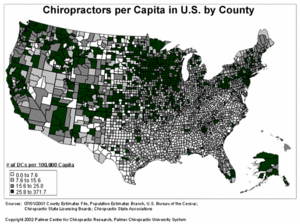The authors began by assembling lists from every chiropractic state licensing board. These lists were merged into a "Preliminary Master Dataset" for comparison, with "nonactive" chiropractic license holders deleted. Comparisons were made within each state to detect and eliminate all "within-state" duplicate records. A comparison was also made of "across-state" licensed DCs, to prevent counting any doctors with multiple state licenses more than once. This required an eight-step algorithm that provided deletion for duplicate records.
County identifiers were added to each remaining name on the Final Master Dataset. These identifiers allowed the authors to locate which doctor practiced in which county. This data was critical in the creation of the distribution map (at right).
The information provided by this study is important for a number of reasons. First, it identifies the areas of the United States that are chiropractically underserved. Establishing this information opens the door to possible federal incentives to doctors willing to practice in these underserved areas.
Second, this study shows that the growth of the chiropractic profession is not stagnant, as some have suggested. With 2,000-3,000 new DCs graduating each year, it can be expected that the chiropractic profession in the United States will grow by at least 1,500 new doctors annually, even with a certain amount of attrition.
It is hoped that this study can be replicated in another five years or so, to track changes in the U.S. chiropractic population and its representation in underserved areas.
Reference:
Smith M, Carber L. Chiropractic health care in health professional shortage areas in the United States. American Journal of Public Health 2002:92(12), pp. 2001-2009.
Dynamic Chiropractic editorial staff members research, investigate and write articles for the publication on an ongoing basis. To contact the Editorial Department or submit an article of your own for consideration, email
.





